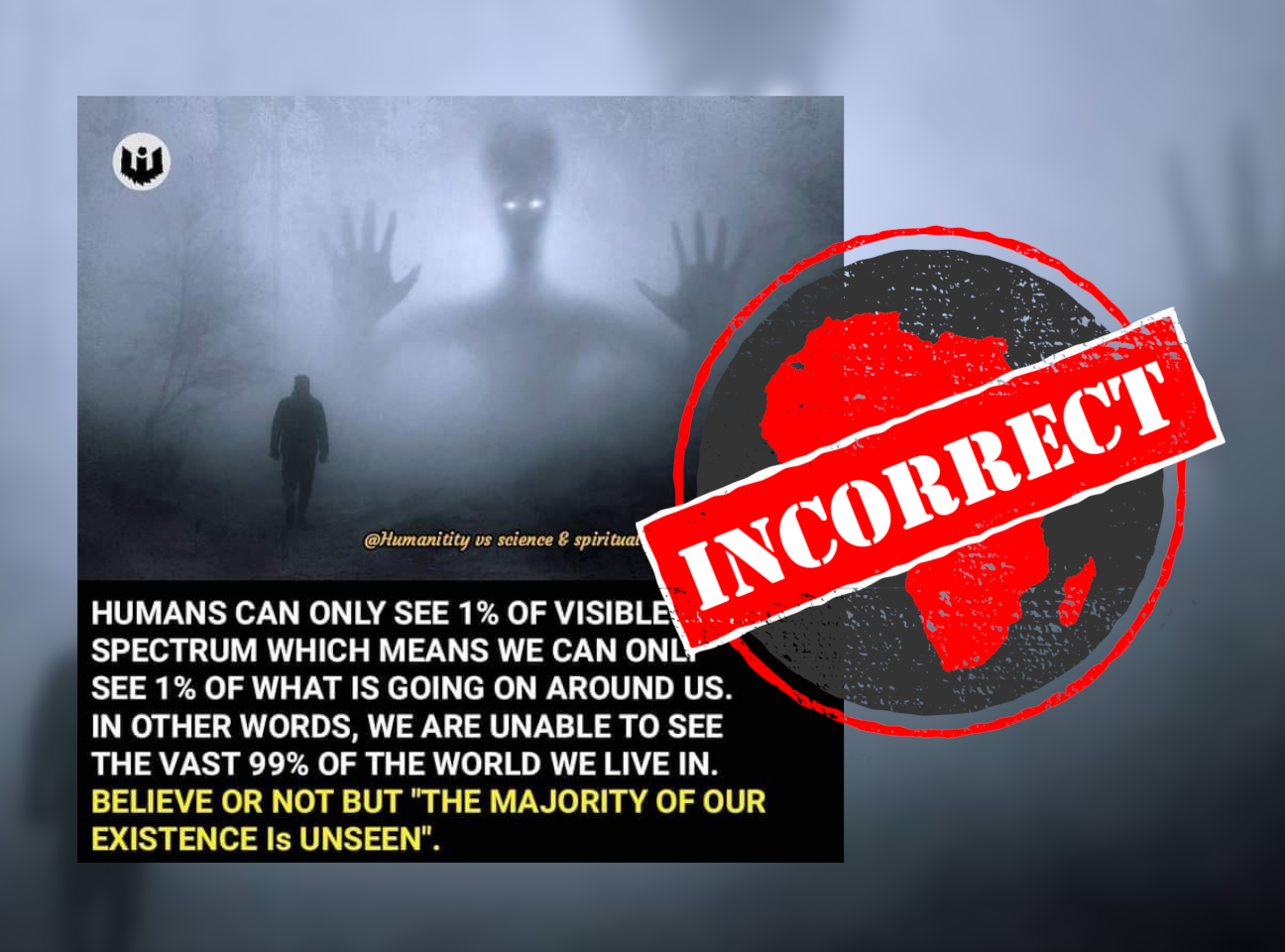IN SHORT: Visible light is just one type of electromagnetic radiation, and the visible light spectrum a tiny part (0.0035%) of the much bigger electromagnetic spectrum. Visible light is so named because it’s light we can see. We see 100% of it, not the 1% claimed in a graphic.
“Humans can only see 1% of visible light spectrum which means we can only see 1% of what is going on around us,” reads a graphic doing the rounds on Facebook in South Africa and elsewhere. “In other words, we are unable to see the vast 99% of the world we live in.”
It adds: “Believe or not but ‘the majority of our existence is unseen’.”
One version was viewed more than 41,000 times in just 24 hours. It includes an illustration of a shadowy figure with glowing eyes looming over a person in a foggy night sky.
The graphic can also be seen here, here and here.
Visible light exists on a larger spectrum, an electromagnetic spectrum that ranges according to its wavelength. Visible light is indeed just a tiny part of this spectrum.
But by definition, visible light is light people can see. This means we see 100% of the visible light spectrum.
Let’s break down the facts.

What is the electromagnetic spectrum?
Electromagnetic energy, also known as electromagnetic radiation, travels across the universe – including Earth – in waves.
Different types of electromagnetic energy fall on the electromagnetic spectrum according to the length of their waves, or wavelength. The longer the wavelength, the lower the energy of the radiation.
The spectrum ranges from very long radio waves to very short gamma rays. Other parts of the spectrum are microwaves, infrared light, ultraviolet radiation, X-rays – and visible light.
A graphic created by Britannica shows some areas of the electromagnetic spectrum:
The graphic shows that the radiation on the electromagnetic spectrum is measured from the longest wavelength to the shortest, which includes:
- Radio waves: broadcasting through radio and TV, for example
- Infrared radiation: a remote control uses infrared light to send signals to its device
- Visible light: the light humans can see (the colours of a rainbow)
- Ultraviolet radiation: the sun is an example of natural UV radiation but there are also artificial sources like tanning beds
- X-rays: these can pass through our bodies, and so are used to take photos of our bones and organs for medical purposes
- Gamma rays: lightning can emit gamma ray flashes
Because the electromagnetic spectrum describes all these types of light, most of the light in the universe is actually invisible to us. But the visible spectrum is not.
What is visible light?
Electromagnetic radiation also carries particles or quantum units known as photons. It is both a wave and a particle.
The visible light we see are these particles bouncing off the objects around us and into our eyeballs. We perceive this light as colour.
Wavelength also determines the colour of light. The visible spectrum ranges from red, which has the longest wavelength (some 700 nanometres), to violet, which has the shortest (about 380 nanometres).
A nanometre is one-billionth of a metre. One millimetre is made up of 10 million nanometres.
The rainbow of colours on the visible spectrum blend into each other, but in English we name the colours between red and violet as orange, green, yellow, blue, indigo and violet.
While we can see 100% of the visible spectrum – not 1% – we see very little of the total electromagnetic spectrum. And that share is even less than 1%. Light visible to humans makes up just 0.0035% of the electromagnetic spectrum.
Other animals can see more than visible light. Bees, for example, use ultraviolet light to detect patterns on flowers. Some snakes use infrared light to detect the body heat of their prey.
David Attenborough’s Life in Colour TV show reveals, through innovative technology, the different colours on the electromagnetic spectrum that other species can see, but we can’t.
The graphic is incorrect. The visible light spectrum gets its name from the fact that people can see all of it, not just 1%. And it makes up only 0.0035% of the total electromagnetic spectrum – again, not 1%.
Republish our content for free
For publishers: what to do if your post is rated false
A fact-checker has rated your Facebook or Instagram post as “false”, “altered”, “partly false” or “missing context”. This could have serious consequences. What do you do?
Click on our guide for the steps you should follow.
Publishers guideAfrica Check teams up with Facebook
Africa Check is a partner in Meta's third-party fact-checking programme to help stop the spread of false information on social media.
The content we rate as “false” will be downgraded on Facebook and Instagram. This means fewer people will see it.
You can also help identify false information on Facebook. This guide explains how.


Add new comment